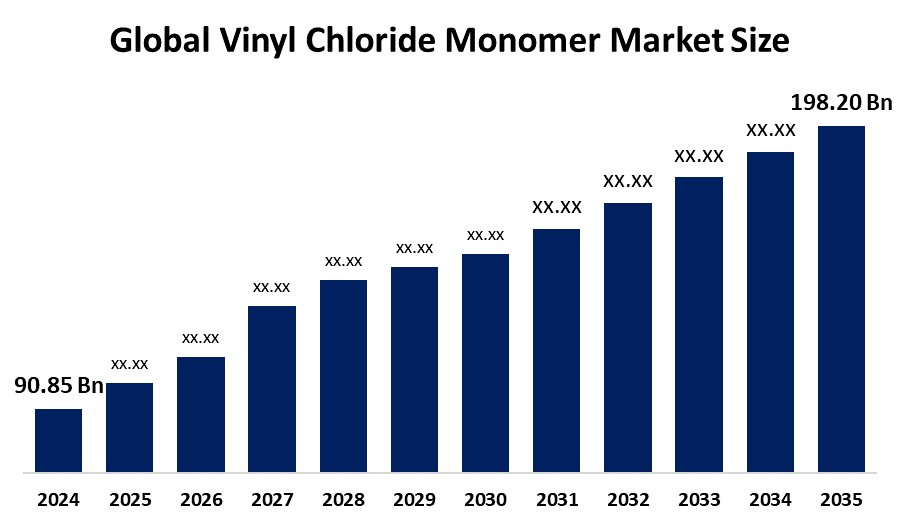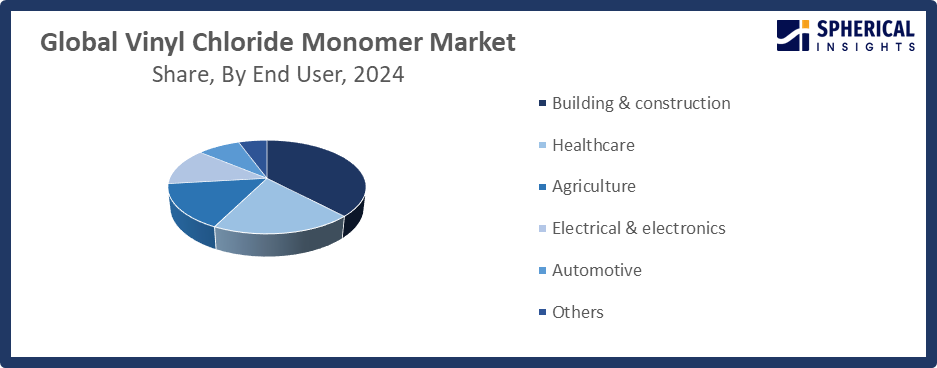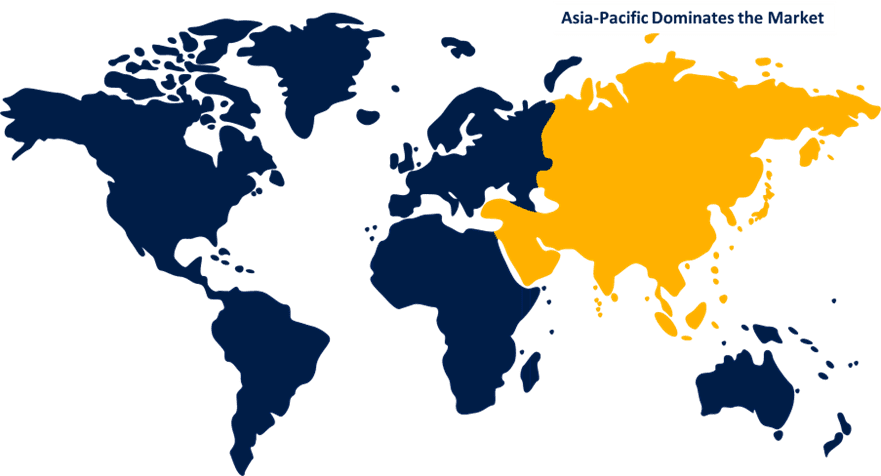Global Vinyl Chloride Monomer Market Size, Share, and COVID-19 Impact Analysis, By Application (PVC, Copolymer resins, and Chlorinated Solvents), By End User (Building & Construction, Healthcare, Agriculture, Electrical & Electronics, Automotive, and Others), and By Region (North America, Europe, Asia-Pacific, Latin America, Middle East, and Africa), Analysis and Forecast 2025 - 2035
Industry: Chemicals & MaterialsGlobal Vinyl Chloride Monomer Market Size Insights Forecasts to 2035
- The Global Vinyl Chloride Monomer Market Size Was Estimated at USD 90.85 Billion in 2024
- The Market Size is Expected to Grow at a CAGR of around 7.35% from 2025 to 2035
- The Worldwide Vinyl Chloride Monomer Market Size is Expected to Reach USD 198.20 Billion by 2035
- North America is expected to Grow the fastest during the forecast period.

Get more details on this report -
According to a Research Report Published by Spherical Insights and Consulting, The Global Vinyl Chloride Monomer Market Size was worth around USD 90.85 Billion in 2024 and is predicted to Grow to around USD 198.20 Billion by 2035 with a compound annual growth rate (CAGR) of 7.35 % from 2025 to 2035. The market for vinyl chloride monomer has opportunities for growing PVC production forms, rising demand in the building and automotive industries, and expansion in emerging nations propelled by urbanization and industrialization trends.
Global Vinyl Chloride Monomer Market Forecast and Revenue Outlook
- 2024 Market Size: USD 90.85 Billion
- 2035 Projected Market Size: USD 198.20 Billion
- CAGR (2025-2035): 7.35%
- Asia Pacific: Largest market in 2024
- North America: Fastest growing market
Market Overview
The global ecosystem that includes the manufacture, distribution, and use of vinyl chloride monomer (CH2=CHCl), a colorless, volatile gas that is the primary feedstock for the synthesis of polyvinyl chloride (PVC) resin, is known as the vinyl chloride monomer (VCM) market. The vinyl chloride monomer is primarily produced by thermal pyrolysis of ethylene dichloride, which is produced from ethylene and chlorine by direct chlorination or oxychlorination methods. It supports a multibillion dollar industry that is essential to downstream uses. According to AGC Inc. launched a chlor-alkali capacity expansion in Thailand in Q1 2025, boosting chlorine supply for VCM synthesis. Meanwhile, Qatar Vinyl Company's 350,000 t/yr PVC plant in Mesaieed launched operations in September 2025, supporting regional VCM demand and growth. A major factor driving up demand for vinyl chloride monomer is the automotive industry's growing reliance on robust yet lightweight materials to improve fuel efficiency and lower carbon emissions. The growing urbanization and infrastructure development in emerging economies is also supplying and meeting the demand for the commodity. Further expansion will be fueled by the growing usage of vinyl chloride monomer in the production of medical equipment such as intravenous bags and medical tubes due to its safety and adherence to medical standards.
Key Market Insights
- Asia Pacific is expected to account for the largest share in the vinyl chloride monomer market during the forecast period.
- In terms of application, the PVC segment is projected to lead the vinyl chloride monomer market throughout the forecast period
- In terms of end user, the building & construction segment captured the largest portion of the market
Vinyl Chloride Monomer Market Trends
- Increasing R&D expenditures for safer VCM handling and storage
- Growing focus on ecologically friendly and sustainable production methods
- Increased capacity and the opening of new plants in the Middle East and Asia-Pacific
- Growing PVC demand in the automotive, healthcare, and building & construction sectors
- Major chemical corporations engaging in strategic joint ventures, acquisitions, and mergers
- Technological developments intended to lower emissions and increase manufacturing efficiency
Report Coverage
This research report categorizes the vinyl chloride monomer market based on various segments and regions, forecasts revenue growth, and analyzes trends in each submarket. The report analyzes the key growth drivers, opportunities, and challenges influencing the vinyl chloride monomer market. Recent market developments and competitive strategies, such as expansion, type launch, development, partnership, merger, and acquisition, have been included to draw the competitive landscape in the market. The report strategically identifies and profiles the key market players and analyzes their core competencies in each sub-segment of the vinyl chloride monomer market.
Global Vinyl Chloride Monomer Market Report Coverage
| Report Coverage | Details |
|---|---|
| Base Year: | 2024 |
| Market Size in 2024: | USD 90.85 Billion |
| Forecast Period: | 2025-2035 |
| Forecast Period CAGR 2025-2035 : | 7.35% |
| 2035 Value Projection: | USD 198.20 Billion |
| Historical Data for: | 2020-2023 |
| No. of Pages: | 175 |
| Tables, Charts & Figures: | 110 |
| Segments covered: | By Application, By End User and COVID-19 Impact Analysis |
| Companies covered:: | BASF, Bayer, LG Chem, Dow Dupont, Agc Chemicals, Nova Chemical, Ineos Styrolution, Reliance Industries, Westlake Corporation, Jubail Chevron Phillips, Formosa Plastics Group, LyondellBasell Industries, Occidental Chemical Corporation, Qatar Vinyl Company Petroquimica Innovay, and Others |
| Pitfalls & Challenges: | COVID-19 Impact, Challenges, Future, Growth, & Analysis |
Get more details on this report -
Driving factors
The vinyl chloride monomer market has been boosted by innovations in PVC recycling and reuse brought about by the recent adoption of more sustainable approaches. The growing need for strong, lightweight materials across a range of end-use sectors, including construction, packaging, and automobiles, is further driving the vinyl chloride monomer market. As the biggest consumer of PVC products made from VCM, the building and building & construction sector is expanding, which is driving the market's notable growth. Increased global automotive production and sales will benefit the vinyl chloride monomer market. The vinyl chloride monomer market is driven by the growing demand for PVC in the automotive, packaging, and building & construction industries, which is being driven by infrastructure projects and urbanization.
Restraining Factor
The market for vinyl chloride monomer is restricted by strict environmental regulations due to its toxic nature, serious health and safety issues, fluctuating raw material prices, and varying demand across end-use industries. Every single one of these factors works against the market's ability to grow sustainably and attract investment.
Market Segmentation
The global vinyl chloride monomer market is divided into application and end user.
Global Vinyl Chloride Monomer Market, By Application:
- The PVC segment dominated the market in 2024 and is projected to grow at a substantial CAGR during the forecast period.
Based on application, the global vinyl chloride monomer market is segmented into PVC, copolymer resins, and chlorinated solvents. Among these, the PVC segment dominated the market in 2024 and is projected to grow at a substantial CAGR during the forecast period. The demand for PVC products is expected to increase as a result of emerging markets' urbanization and infrastructure development. Furthermore, the material's exceptional properties make it helpful for modernizing industrial components like windows, flooring, pipelines, and other fittings. Modern formulations' increased environmental friendliness and improved recycling techniques add to PVC's allure.
The copolymer resins segment in the vinyl chloride monomer market is expected to grow at the fastest CAGR over the forecast period. The growing need for high-performance polymers in specialized applications, including consumer electronics, industrial equipment, and medical devices, is responsible for the expansion of the copolymer resins market.
Global Vinyl Chloride Monomer Market, By End User:
- The building & construction segment accounted for the largest share in 2024 and is anticipated to grow at a significant CAGR during the forecast period.
Based on end user, the global vinyl chloride monomer market is segmented into building & construction, healthcare, agriculture, electrical & electronics, automotive, and others. Among these, the building & construction segment accounted for the largest share in 2024 and is anticipated to grow at a significant CAGR during the forecast period. The substantial use of polyvinyl chloride (PVC), which is derived from VCM, in pipes, fittings, window frames, flooring, and insulation materials, is the main cause of the building and building & construction industry. Reusing PVC has also been accelerated by the shift to more environmentally friendly and energy-efficient building techniques owing to its excellent insulation and longevity.

Get more details on this report -
The healthcare segment in the vinyl chloride monomer market is expected to grow at the fastest CAGR over the forecast period. The growing need for medical-grade PVC in applications including IV bags, tubing, blood storage containers, and other disposable medical devices is fueling the expansion of the healthcare market.
Regional Segment Analysis of the Global Vinyl Chloride Monomer Market
- North America (U.S., Canada, Mexico)
- Europe (Germany, France, U.K., Italy, Spain, Rest of Europe)
- Asia-Pacific (China, Japan, India, Rest of APAC)
- South America (Brazil and the Rest of South America)
- The Middle East and Africa (UAE, South Africa, Rest of MEA)
Asia Pacific Vinyl Chloride Monomer Market Trends

Get more details on this report -
Asia Pacific is expected to hold the largest share of the global vinyl chloride monomer market over the forecast period.
Growing investments in residential and commercial buildings in China, India, the Philippines, Vietnam, and Indonesia allowed the Asia-Pacific region to dominate the worldwide market share. The availability of raw materials, investments in chemical production facilities, and favorable government efforts all contribute to the region's market expansion. For example, China's building output value peaked in 2022 at over CNY 27.63 trillion (USD 4.10 trillion), according to the country's National Bureau of Statistics. The growing construction, automotive, and packaging industries in the area are also contributing to an increase in VCM use.
China Vinyl Chloride Monomer Market Trends
China is driven by strong demand from the nation's growing packaging, automobile, and building & construction industries. The need for residential development in China is anticipated to continue to be driven by rising family income rates and population movement from rural to urban areas. A greater focus on affordable housing in the public and private sectors would encourage growth in the residential building & construction industry.
Japan Vinyl Chloride Monomer Market Trends
Japan's well-established electronics, automotive, and building & construction industries are its main drivers. Japan prioritizes the production of high-quality PVC, backed by strict environmental standards and cutting-edge manufacturing methods. Due to its technological know-how, robust domestic demand, and strategic export operations in the Asia-Pacific area, Japan continues to be a major player in the VCM industry even though its growth has been slower than that of emerging economies.
North America Vinyl Chloride Monomer Market Trends
North America is expected to grow at the fastest CAGR in the vinyl chloride monomer market during the forecast period.
The growing demand for PVC in building forms such as siding, flooring, window frames, and pipes is directly related to the vinyl chloride monomer industry in the United States. The rising demand for polyvinyl chloride (PVC) in important end-use industries like packaging, automotive, and building & construction is driving North America's faster growth. The region's focus on housing developments, industrial expansion, and infrastructural development helps to sustain market growth. Additionally, as environmental consciousness has grown, sustainable production practices have been adopted, which has improved market dynamics.
U.S Vinyl Chloride Monomer Market Trends
Unmatched access to inexpensive shale-derived ethylene, ethylene dichloride pyrolysis for VCM synthesis optimization, and production cost reductions of up to 20% compared to worldwide norms are the main drivers of the US market. The use of polyvinyl chloride (PVC), which is generated from VCM, is being driven primarily by the nation's substantial infrastructure building and renovation efforts.
Canada Vinyl Chloride Monomer Market Trends
The demand for vinyl chloride monomer (VCM) in the packaging, automotive, and building & construction sectors is driving the market in Canada. Growing urbanization and infrastructure projects increase demand for polyvinyl chloride (PVC), the main VCM derivative. The efficient production of VCM is supported by technology improvements and raw material accessibility for Canada's chemical manufacturing industry.
Competitive Analysis:
The report offers the appropriate analysis of the key organizations/companies involved within the global vinyl chloride monomer market, along with a comparative evaluation primarily based on their type of offering, business overviews, geographic presence, enterprise strategies, segment market share, and SWOT analysis. The report also provides an elaborate analysis focusing on the current news and developments of the companies, which includes type development, innovations, joint ventures, partnerships, mergers & acquisitions, strategic alliances, and others. This allows for the evaluation of the overall competition within the market.
Worldwide Top Key Players In The Vinyl Chloride Monomer Market Include
- BASF
- Bayer
- LG Chem
- Dow Dupont
- Agc Chemicals
- Nova Chemical
- Ineos Styrolution
- Reliance Industries
- Westlake Corporation
- Jubail Chevron Phillips
- Formosa Plastics Group
- LyondellBasell Industries
- Occidental Chemical Corporation
- Qatar Vinyl Company Petroquimica Innovay
- Others
Key Target Audience
- Market Players
- Investors
- End-users
- Government Authorities
- Consulting And Research Firm
- Venture capitalists
- Value-Added Resellers (VARs)
Recent development
- In December 2024, Reliance Industries Limited (RIL) launched a stable pricing approach by keeping its Polyvinyl Chloride (PVC) rates unchanged in Indian domestic markets, reflecting strategic pricing discipline amid prevailing economic conditions.
- In April 2023, AGC launched its VCM Manufacturing Plant in Indonesia and implemented Process Digital Twin technology for chemical plants.
- In May 2023, Tarkett launched a brand-new line of non-PVC planks and tiles that highlights the company's all-encompassing support of businesses in achieving their sustainable development goals.
Market Segment
This study forecasts revenue at the global, regional, and country levels from 2020 to 2035. Spherical Insights has segmented the vinyl chloride monomer market based on the following segments:
Global Vinyl Chloride Monomer Market, By Application
- PVC
- Copolymer resins
- Chlorinated Solvents
Global Vinyl Chloride Monomer Market, By End User
- Building & construction
- Healthcare
- Agriculture
- Electrical & electronics
- Automotive
- Others
Global Vinyl Chloride Monomer Market, By Regional Analysis
- North America
- US
- Canada
- Mexico
- Europe
- Germany
- UK
- France
- Italy
- Spain
- Russia
- Rest of Europe
- Asia Pacific
- China
- Japan
- India
- South Korea
- Australia
- Rest of Asia Pacific
- South America
- Brazil
- Argentina
- Rest of South America
- Middle East & Africa
- UAE
- Saudi Arabia
- Qatar
- South Africa
- Rest of the Middle East & Africa
Frequently Asked Questions (FAQ)
-
1. What is the CAGR of the vinyl chloride monomer market over the forecast period?The global vinyl chloride monomer market is projected to expand at a CAGR of 7.35% during the forecast period.
-
2. What is the market size of the vinyl chloride monomer market?The global vinyl chloride monomer market size is expected to grow from USD 90.85 billion in 2024 to USD 198.20 billion by 2035, at a CAGR 7.35% of during the forecast period 2025-2035.
-
3. Which region holds the largest share of the vinyl chloride monomer market?Asia Pacific is anticipated to hold the largest share of the vinyl chloride monomer market over the predicted timeframe.
-
4. Who are the top companies operating in the global vinyl chloride monomer market?BASF, Bayer, LG Chem, Dow Dupont, AGC Chemicals, Nova Chemicals, Ineos Styrolution, Reliance Industries, Westlake Corporation, Jubail Chevron Phillips, formosa Plastics Group, LyondellBasell Industries, Occidental Chemical Corporation, Qatar Vinyl Company, Petroquimica Innovay, and others.
-
5. What factors are driving the growth of the vinyl chloride monomer market?The growth of the vinyl chloride monomer market is driven by rising demand for PVC in construction, automotive, and packaging sectors, coupled with rapid industrialization and infrastructure development in emerging economies.
-
6. What are market trends in the vinyl chloride monomer market?Key market trends include technological advancements in VCM production, increased focus on sustainable manufacturing practices, capacity expansions in Asia-Pacific, and strategic collaborations among leading chemical manufacturers.
-
7. What are the main challenges restricting wider adoption of the vinyl chloride monomer market?The Main challenges include stringent environmental regulations, health and safety concerns associated with VCM exposure, raw material price volatility, and the high capital investment required for safe and compliant production facilities.
Need help to buy this report?